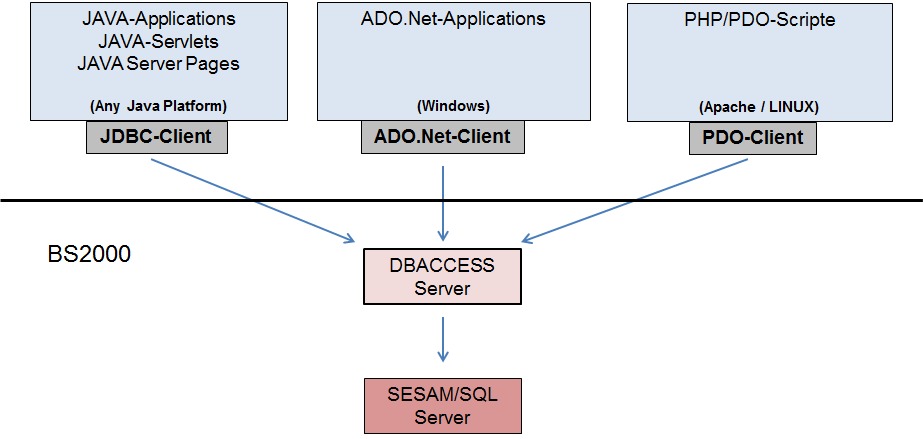SESAM-DBAccess consists of client components and a server component.
JDBC Client
The JDBC Client is intended for users working with a platform which offers a Java Virtual Machine (e.g. Windows, Unix systems and BS2000) and provides access to a SESAM/SQL database via a JDBC interface from Java applications, Java Servlets, and Java Applets.
JDBC is a Java API used to execute SQL statements. It consists of many classes and interfaces written in Java. JDBC is a standard API which allows developers of Java applications, Java Servlets, and Java Applets to use an interface written purely in Java to access databases.
Independently of the system platform on which it runs, the JDBC Client has the following tasks:
Handling the connection to DBAccess Server
Forwarding requests to DBAccess Server
Receiving responses from DBAccess Server
ADO.NET Client
ADO.NET is the interface defined by Microsoft in the context of ADO (ActiveX Data Objects) technology for .NET Clients to permit Windows systems to communicate with database systems via the internet.
The ADO.NET Client has the following tasks:
Handling the connection to DBAccess Server
Forwarding requests to DBAccess Server
Receiving responses from DBAccess Server
PDO Client for PHP applications
PHP (PHP: Hypertext Preprocessor) is a script language with a syntax based on C and Perl which is used principally to create dynamic websites or web applications. PHP applications are used, among other things, to communicate with database systems via the internet.
The PDO Client has the following tasks:
Handling the connection to DBAccess Server
Forwarding requests to DBAccess Server
Receiving responses from DBAccess Server
DBAccess Server
DBAccess Server (BS2000) provides JDBC,.NET, and PDO Clients with access to the SESAM/SQL database system.
DBAccess Server has the following tasks:
Verifying access authorization
Accepting requests from clients and forwarding them to the database system
Accepting responses from the database system and forwarding them to the client
Handling communication with the database System
Configuration of the complete system

